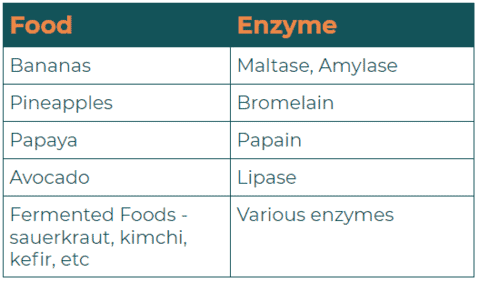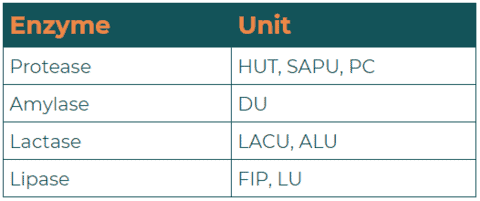Digestive enzymes are compounds secreted by our bodies to help us break down all the num num stuff we eat. They’re released at different points of the luge we call our GI tracts by many different organs and cells. In the end, digestive enzymes ensure the foods we eat actually go into our bloodstream to do all the great stuff they do.
Most of us have plenty of these unsung heroes floating around our GI tract. There are diseases or conditions that result in a reduction of these digestive enzymes. For those people, both the pharmaceutical and natural products industry will help you part with your money, I mean, replace your enzymes.
To be informed consumers, we must understand digestive enzymes fundamentally. From there, we can pretty easily pick out the good supplements from the bad and know when to use what.
How We Digest Food
Digestion is a combination of the mechanical and chemical breakdown of our foods into the nutrients needed to make us tick. When we say “mechanical breakdown,” we mean physically breaking big pieces into smaller ones via chewing or rumble-grumble of our stomach. Chemical breakdown involves the enzymes and other compounds that attack our food at the molecular level to turn big molecular chains of foods into small, absorbable fragments.
Digestion starts when we think about or even just look at food. The system spins up, increasing the secretion of hormones, enzymes, and compounds that will be used in the early digestion of foods. Our bodies can’t wait; like a pit stop crew in Nascar, we have to be ready to act the moment food hits our mouths..
Different parts of your GI tract get involved at different times to facilitate digestion. Your biology teacher taught this by passing out crackers, asking the class to hold one in their mouths and not chew it. I should clarify that everyone got their own cracker – it wasn’t a collective cracker that was shared. That’d be gross. Simple carbs (like crackers and bread) will be digested first in the mouth by those enzymes and will be mush with no chewing or stomach acid needed.
Other organs important in digestion are the stomach, intestines, and pancreas. The stomach is a mixing bowl, with the muscles contracting to physically mix the foods in the bowl of acid and digestive juices around to further the breakdown. The primary digestive enzymes secreted here are proteases, or protein-eating enzymes.
It moves down the GI tract where the pancreas adds in its two cents. It adds bile, an agent to help break down fats and some more digestive enzymes. In the small intestines, digestive enzymes work on breaking down and absorbing our nutrients.
Digestive Enzyme Basics
If you didn’t know this, I was a DJ in college. My DJ name was DJ Enzyme, because I broke it down. The first part is true, but not the second part.
Digestive enzymes are the specialized proteins that chemically break down macronutrients into more digestible, smaller fragments. If it’s been a while since you’ve read our nutrition articles, macronutrients are the big (macro) nutrients we get from food: protein, fats, and carbohydrates. Micronutrients are the vitamins and smaller compounds found in foods.
To help you visually understand this, think about enzymes as if they are little Pac-Man guys. The food compounds are the ghosts, cherries, etc.
There are different enzymes that break down all the different proteins, fats, and carbs we eat. Bread and asparagus are both carbohydrates, but are obviously structurally different and must be handled differently. Enzymes are secreted at different stages of digestion as well. For example, the mouth secretes an enzyme to break sucrose (a really long chain of sugars) down to maltose (a small pair of sugars), and then the intestines break maltose into the single sugar compounds glucose.
Types of Digestive Enzymes
Here is a basic table of some digestive enzymes and which macronutrients they work on:

Notice they all end in -ase? That’s because scientists like consistency and name enzymes with the thing they are breaking down plus -ase at the end. Sort of like how they name kitchen appliances.
One thing to note about that table. We, along with many vertebrates, lack the enzyme cellulase. Cellulose is the group of carbohydrates that make up plant cell walls and plant structures. We can’t break down these compounds and digest them. Undigested plant structures become dietary fiber in humans. We’ll have a whole article on fiber in the very near future.
Digestive Enzyme Deficiency
If the system works well, I wouldn’t have to write about it, would I?
For various reasons, people can be lacking in one or more digestive enzymes. Someone with pancreatic insufficiency would not be producing enough enzymes or bile to break down foods. This is usually caused by things like cystic fibrosis, diabetes, or pancreatic cancer. Some types of bariatric surgeries will induce pancreatic insufficiency, making fat absorption difficult.
Genetics plays a big role, too. It’s estimated that 60% of the global population lacks the enzyme lactase, which is responsible for breaking down milk-sugars. Lactose intolerance, as it is known, is very region-specific; Nearly 90% of eastern Asian people will not produce enough lactase, where only 5% of northern European people won’t.
For the rest of us, having discomfort after eating certain foods is enough justification to consider additional digestive enzymes. As undigested foods, sugars, in particular, move farther down the GI tract than they should be, the bacteria living in the gut will start to gobble them up. The fermentation process produces gas, resulting in bloating and pain. In 1990, a gent was upset with gas after eating legumes and invented Beano, which is alpha-galactosidase, a bean-based carb chomper. People with inflammatory bowel or other gastric disorders will be even more sensitive to the effects of malabsorption.
Food Sources of Digestive Enzymes
Some foods have enzymes that aid in digestion. Here’s a snapshot:

We should not rely on dietary sources of enzymes. Firstly, we don’t have to. In general, our body makes enough enzymes to facilitate digestion. Secondly, the number of active enzymes will be low in any given food, plus that amount will vary from crop to crop, so consistency will be a real problem. Finally, most of our foods are processed in some way – normally cooking – which destroys the enzymes pretty efficiently.
It’s great to eat healthy foods. If they contain digestive enzymes, too, then it’s an added bonus. But we should not rely on our food to be a source of digestive enzymes for us, as enzymes found in foods aren’t a part of the digestive process.
Digestive Enzyme Supplementation
First, let’s be clear about what a digestive enzyme supplement (or prescription) will actually do for us. Digestive enzyme supplements are replacing things our body doesn’t make enough of. They are not fixing any underlying problems; digestive enzymes are a temporary addition for digestion of the current meal or snack. Using digestive enzymes is a permanent thing, though, taken at least with every problem food. For some people, they are taken every time they eat.
Digestive enzymes will help reduce GI symptoms caused by those foods we are not properly digesting. There is no evidence that taking digestive enzymes will give a normal, healthy person super-human digestion, maximizing or optimizing your nutrient uptake. That’s literally a thing that some quacks are promoting.
That covers the basics. Let’s get into buying a digestive enzyme…
You know how I feel about digestive enzyme products?

I’ve been using memes a bit more in my content creation…
Let’s look at all the things we must consider before we purchase a digestive enzyme supplement…
Potency
When we discussed probiotics, we talked about paying attention to the CFU, not probiotic weight. Just because you use a gram of probiotic, doesn’t mean all of those little bacteria are alive or capable of colonizing, reproducing, and growing. We use the CFU to show the activity of a probiotic and milligrams to represent weight.
A crude analogy: dead bodies still have weight, but won’t be an effective running defense against The Cincinnati Bears (aka Dahhhh Bears).
The same goes for digestive enzymes. Any manufacturer that lists ONLY the weight in the Supplement Facts Panel is hoping you don’t know better. What matters most with an enzyme is its activity level, or its ability to break stuff down.
These units are specific to two points: the source of the enzyme (animal enzymes will use different units than enzymes cultured from microbes) and the enzyme itself. Each digestive enzyme will have its own unique unit of measure and that unit may be different depending on where the enzyme comes from.
The full catalog is listed in the Food Chemical Codex (FCC). You can spend the $300 and get access to it, but there are a few sources around that have a pretty comprehensive list. We have such a thing, but aren’t going to publish it here due to copyright, uh, “stuff.”
Here’s an example list:

BEWARE: Some manufacturers are, without reservation, jerks. They will use fake units to seem legitimate as they know many consumers are unaware of all of these intricacies. I’ve seen “Lipase 3000 FCC” for example. FCC is the name of the list, not the unit. We’ve seen this with probiotics, too. They’ll use fake strain names like “LIB” which just stands for “large intestine bacteria.”
Survivability
Enzymes are a delicate thing. Under the wrong conditions, they’ll break down. This is why our digestive processes are a well-timed play, with characters entering and exiting after performing their part at different times. A small intestine enzyme probably won’t survive the harsh pH of the stomach, otherwise, it would be secreted by the stomach!
When we take digestive enzymes, we want enzymes that will do one thing:

We can accomplish this by enteric coating the enzyme. Most prescription digestive enzymes will do this. There are not many over-the-counter products that are enteric-coated that are worth mentioning. We try to avoid gross compounds in enteric coatings like phalates or parabens. Only use enteric-coated products that list the full ingredients used in their coating.
Outside of enteric coating, one strategy to ensure some survival is to use a comprehensive set of enzymes. A mix of proteases, lipases, and carbohydrases will mean some will survive and others will not, working at different parts of the digestive tract.
Enzymes should be tested to ensure survivability at different pH’s.
Dosing
A dozen or so different enzymes, all with different units of activity, that may or may not survive the gut. Sounds like you guys are going to have no problem figuring out what dose to use, right?
I don’t blame you. I’ve studied this stuff extensively, and I would almost definitely need to consult a chart or two about what dose is good enough for what.
Here’s a rule of thumb: Big numbers are good. However, the enzyme dose should be based on the diet you actually have (or need to treat). If you are a snack-a-saurus, eating way too many carbs, don’t fool yourself and get a protein-heavy digestive enzyme. If you are lactose intolerant, it doesn’t make much sense to get a comprehensive enzyme that has a low dose of lactase.
Here are a few scenarios I’ll propose for you to try to simplify digestive enzyme use:

Other Quality Concerns
Pancreatic enzymes are often made from piggies. Any animal-based digestive enzymes should be from antibiotic and hormone-free sources.
Digestive enzyme products should be tested for contaminants such as mold, yeast, and bacteria like normal. There was a scare a few years back where a strong, dangerous antibiotic called chloramphenicol was found in products. It was tracked back to a company in India and highlights the dangers of buying products from retailers who aren’t obsessive like us.
How To Take Digestive Enzymes
It’s time for the REAL take-home message of this article. I’ve been in practice for 15 years now, and…

The big misconception is you should take digestive enzymes right when you eat or even after you eat if you have GI distress. Not true. Digestion starts when we look at/think about food. If we need to use digestive enzymes, those enzymes need to be ready to go just before we eat. All digestive enzymes should be taken 15-20 minutes before you eat.
Here’s my Kool-Aid analogy.
How do you make Kool-Aid? Despite the fact its gross fake food with horrible dyes etc, you make it by mixing a powder with a pitcher of water. If the pitcher is clear glass, has arms, legs, and a smile, then even better.
Add the powder to the water and mix it up. We wait for the powder to evenly mix before we drink it. Digestive enzymes are similar.
The pitcher of water is our stomach and the powder is the digestive enzyme. We need to have the Kool-Aid properly mixed before we add food to the stomach/pitcher.
Taking digestive enzymes with the first bite of the meal is like adding the powder and not mixing, just drinking. You’ll get an unmixed, unevenly distributed amount of activity.
Taking digestive enzymes after you eat is like drinking the water and then eating the powder.
Take digestive enzymes no more than 20 minutes before you eat anything. Any longer and your stomach will start to empty, draining out your Kool-Aid from the pitcher before you can even enjoy it.
Breaking Down Digestive Enzymes
Digestive enzymes are often recommended in the natural product world for everything. Almost every gastric disorder requires digestive enzyme intake and malabsorption is the cause of all human suffering.
We take a slightly more tempered approach than that. There are many among us that have diseases or conditions that may affect our digestive enzyme production. Genetic factors play a big role in some of these deficiencies. For these people, it is a no-brainer to choose a good quality digestive enzyme.
For the rest of us, we would use a well-made digestive enzyme to relieve any GI symptoms we may be having, with a clearer understanding of what they actually can do for us. They aren’t going to fix any problems; healthy food choices and nutrients like probiotics, collagen, and more will improve GI health. There are so many different reasons for GI distress, especially related to foods, such as acid reflux or dietary intolerances. Increased digestive enzymes will only help with a small portion of these problems.
Choosing a digestive enzyme is like solving a 16 sided Rubik’s cube. Easy if you’re trained and practiced. Nearly impossible if not. Look for a comprehensive selection of enzymes that are labeled based on their activity level in units, not their weight in milligrams. Find a trusted source, take it correctly, and be honest with the effects.
That should be fairly easy to digest!
Just trying to keep it real…

Neal Smoller, PharmD
Owner, Pharmacist, Big Mouth



